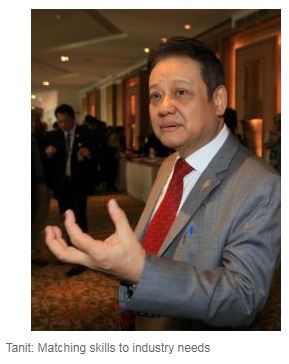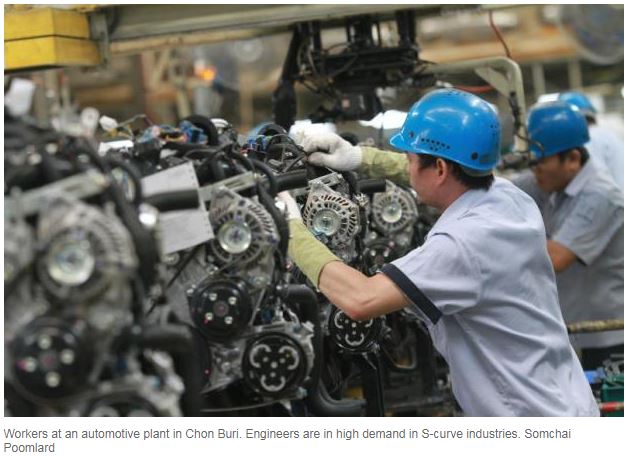Thailand: How to meet changing labour demand
Thailand’s labour structure outlook in 2019 is expected to change in terms of the number of workers because the country has a low birth rate and the ageing population is gradually climbing.
But the crisis has been projected for many years, that new local workers are insufficient to support the country’s business and industrial sectors in the long run.
Tanit Sorat says that not only is the labour shortage a huge problem for Thailand’s development, but many skilled workers are also mismatched for the demand of employers.
At 69, he has monitored the country’s labour structure using his expertise in wages, occupation trends and labour crises.
Mr Tanit is vice-chairman of the National Labour Development Advisory Council, part of the Labour Ministry, and vice-chairman of the Employers’ Confederation of Thai Trade and Industry.
Ageing workforce
He cited a survey figure from the Labour Ministry that Thailand’s labour structure totals 38 million people, excluding aliens. Of those, 49% are workers with an average age of 40 years.
“Thailand’s average age for workers is higher than that of other regional countries like Vietnam, Myanmar and Indonesia,” he said. “Our concern is that there is a crisis in the long term.”
According to the ministry’s figures, 45% of employees are unskilled workers.
“This means that Thai workers lack the skills that are needed in the current circumstances,” Mr Tanit said.
He said the government should prioritise all labour problems that need to be solved as it promotes the flagship Eastern Economic Corridor (EEC) scheme and creates new workers for the S-curve policy, consisting of 12 targeted industries.
“Overhauling the country’s education system will be an initial stage to solve the mismatch of skills in the market,” Mr Tanit said, adding that current educational institutions cannot produce first-jobbers to meet the demands of companies.
He said there are roughly 400,000 positions that need to be filled, but few people can match companies’ needs.
Thailand needs vocational-level workers more than university-degree ones because the government is positioning the country as the industrial and manufacturing hub of Southeast Asia, so vocational jobbers are needed to serve the market.
Meanwhile, many vocational institutes produce a low rate of new workers to serve the labour market, only 10,000 employees per year.
STEM fields vital
 The country’s higher education system needs an overhaul because the labour market lacks manpower in the STEM (science, technology, engineering, mathematics) fields.
The country’s higher education system needs an overhaul because the labour market lacks manpower in the STEM (science, technology, engineering, mathematics) fields.
Mr Tanit said the EEC is promoting 12 targeted industries: new-generation automobiles; smart electronics; affluent, medical and wellness tourism; agriculture and biotechnology; food; robotics for industry; logistics and aviation; biofuels and biochemicals; digital; medical services; defence; and education.
“These fields are all in STEM education, while other areas — political science, economics and statistics — are shrinking in the labour market,” he said. “The new- jobbers coming from the STEM fields are preferable over others, who will spend a longer time looking for jobs because the current demand is mismatched.”
Shrinking manpower
Mr Tanit said the country’s short-term labour outlook will see the number of staff at financial institutions gradually decline, due to digital disruption from mobile banking apps and internet banking.
“As a matter of fact, we have seen the descending trend since 2018, with banks cutting staff at their branches and closing some branches that are low in profitability,” he said. “Meanwhile, many young people prefer to use mobile apps and the internet to do business.”
In addition, the country’s retail sector — both department stores and convenience stores — will reduce the amount of workers in a bid to adopt new technology for their operations and cut labour costs.
For example, the number of cashiers will be cut in the near future, Mr Tanit said.
The security service sector, which used to need a huge volume of workers in the past, will change to adopt new digital equipment to support and upgrade services.
Mr Tanit said security businesses offer potential amid increasing urbanisation and the growing number of middle-income earners.
“Thai people still need these service solutions to protect their assets and properties from threats such as terrorism and crime,” he said. “Today, technology and innovation for security measures are affecting security guards, so they are being pushed to be able to use digital security equipment.”
The media industry is expected to be directly hit by digital disruption from social media and people’s lifestyle.
Most people now read the news on social media feeds or access media websites, while newspaper sales continue to fall every year.
Many magazines and newspapers have been closed due to a fall in sales and less advertising, Mr Tanit said.
“But the media industry still has a lot of ad spending, which is being shifted more and more to online media,” he said.
For television, people don’t need to go home in a hurry to watch their favourite shows. They can watch them online, anywhere and at any time.
For the labour market in the next five years, the manufacturing sector will suffer from the adoption of artificial intelligence, robotics and automation.
“The industry operators have to plan for these huge investments, so most of them make a decision slowly to upgrade the manufacturing lines,” Mr Tanit said. “Many operators are taking a wait-and-see approach to global technology trends before making investments.”
Sunrise careers
Mr Tanit said bilingual workers are sought after in every sector, particularly those with English and Chinese skills.
“Foreign languages are very important, as the government has many policies to attract new foreign direct investment and promote tourism,” he said.
In addition, tech-savvy executives at every level are in high demand.
Many types of engineers are still matching for the flagship EEC scheme and the S-curve policy. These initiatives are expected to create roughly 500,000 jobs in three eastern provinces.
For the media industry, animation creators are needed because they come with production skills, while social media will also drive demand for animation jobs.
The industry will also need programmers to design animated shows.
Online marketing is coming into its own with the surge in e-commerce. It is a set of tools and methodologies used for promoting products and services on the internet.
A major factor driving online marketing is the popularity of content marketing from public and private organisations, as well as the rise of smartphone and digital media consumers.
Source: https://www.bangkokpost.com/business/news/1614914/how-to-meet-changing-labour-demand


 Thailand
Thailand




